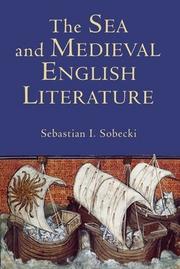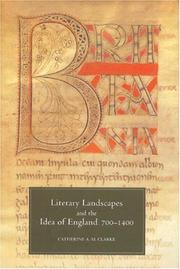| Listing 1 - 5 of 5 |
Sort by
|

ISBN: 1282150774 9786612150777 1846155916 1843841371 Year: 2008 Publisher: Suffolk : Boydell & Brewer,
Abstract | Keywords | Export | Availability | Bookmark
 Loading...
Loading...Choose an application
- Reference Manager
- EndNote
- RefWorks (Direct export to RefWorks)
A fresh and invigorating survey of the sea as it appears in medieval English literature, from romance to chronicle, hagiography to autobiography. As the first cultural history of the sea in medieval English literature, this book traces premodern myths of insularity from their Old English beginnings to Shakespeare's 'Tempest'. Beginning with a discussion of biblical, classical and pre-Conquest treatments of the sea, it investigates how such works as the Anglo-Norman 'Voyage of St Brendan', the Tristan romances, the chronicles of Matthew Paris, 'King Horn, Patience, The Book of Margery Kempe' and 'The Libelle of Englyshe Polycye' shape insular ideologies of Englishness. Whether it is Britain's privileged place in the geography of salvation or the political fiction of the idyllic island fortress, medieval English writers' myths of the sea betray their anxieties about their own insular identity; their texts call on maritime motifs to define England geographically and culturally against the presence of the sea. New insights from a range of fields, including jurisprudence, theology, the history of cartography and anthropology, are used to provide fresh readings of a wide range of both insular and continental writings. SEBASTIAN I. SOBECKI is Professor of Medieval English Literature and Culture, Rijksuniversiteit Groningen.
English literature --- Sea in literature. --- Civilization, Medieval, in literature. --- Ocean in literature --- History and criticism. --- Anglo-Norman literature --- Latin literature, Medieval and modern --- Themes, motives. --- England --- Civilization --- British literature --- French literature --- Inklings (Group of writers) --- Nonsense Club (Group of writers) --- Order of the Fancy (Group of writers) --- British geography. --- Cultural identity. --- Cultural-political complexity. --- Insularity. --- Maritime motifs. --- Medieval English literature.
Book
ISBN: 1787445984 1787449653 1843845466 Year: 2020 Publisher: Cambridge : D.S. Brewer,
Abstract | Keywords | Export | Availability | Bookmark
 Loading...
Loading...Choose an application
- Reference Manager
- EndNote
- RefWorks (Direct export to RefWorks)
New perspectives on one of the most important medieval poets.
Gower, John, --- Criticism and interpretation. --- LITERARY CRITICISM / Medieval. --- Chaucer's contemporary. --- John Gower. --- Studies in the Age of Gower. --- literary analysis. --- literary criticism. --- literary exploration. --- literary perspectives. --- literary scholarship. --- literary studies. --- medieval English literature. --- medieval authors. --- medieval literature. --- medieval poet. --- medieval poetry.
Multi
ISBN: 1843846349 9781843846345 9781800106000 1800106009 1800105991 9781800105997 Year: 2022 Publisher: Cambridge D.S. Brewer
Abstract | Keywords | Export | Availability | Bookmark
 Loading...
Loading...Choose an application
- Reference Manager
- EndNote
- RefWorks (Direct export to RefWorks)
This collection honours the scholarship of Professor David F. Johnson, exploring the wider view of medieval England and its cultural contracts with the Low Countries, and highlighting common texts, motifs, and themes across the textual traditions of Old English and later medieval romances in both English and Middle Dutch.
Comparative literature --- Old English literature --- Medieval Dutch literature --- Festschriften --- literary history --- Europe --- Dutch literature --- English literature --- History and criticism. --- English influences. --- Common Texts. --- Comparative Literature. --- Cross-Cultural Contact. --- Cultural Contacts. --- David F. Johnson. --- Dutch Literature. --- European Context. --- European Literary Traditions. --- Literary Past. --- Literary Scholarship. --- Literary Studies. --- Medieval English Literature. --- Middle Dutch. --- Motifs. --- Old English. --- Textual Traditions. --- Themes.

ISBN: 9781846154850 1846154855 9781843840572 Year: 2006 Publisher: Cambridge D. S. Brewer
Abstract | Keywords | Export | Availability | Bookmark
 Loading...
Loading...Choose an application
- Reference Manager
- EndNote
- RefWorks (Direct export to RefWorks)
Pastoral and locus amoenus traditions in Medieval English literature, and the early mythologisation of English landscape, space and identity through pastoral topoi.
Landscape in literature. --- English literature --- National characteristics, English, in literature. --- Nationalism and literature --- History and criticism. --- History --- England --- In literature. --- Bede. --- English landscape. --- Medieval English literature. --- Old English poetry. --- fourteenth century. --- identity. --- locus amoenus traditions. --- monastic houses. --- mythologisation. --- pastoral. --- regional monastic houses. --- space. --- LITTERATURE ANGLAISE --- PAYSAGES DANS LA LITTERATURE --- 1100-1500 (MOYEN-ANGLAIS) --- 450-1100 (VIEIL ANGLAIS) --- HISTOIRE ET CRITIQUE
Book
ISBN: 1280489014 9786613584243 1846158893 1843842327 Year: 2010 Publisher: Woodbridge, Suffolk, U.K. ; Rochester, N.Y. : D.S. Brewer,
Abstract | Keywords | Export | Availability | Bookmark
 Loading...
Loading...Choose an application
- Reference Manager
- EndNote
- RefWorks (Direct export to RefWorks)
Monsters abound in Old and Middle English literature, from Grendel and his mother in Beowulf to those found in medieval romances such as Sir Gowther. Through a close examination of the way in which their bodies are sexed and gendered, and drawing from postmodern theories of gender, identity, and subjectivity, this book interrogates medieval notions of the body and the boundaries of human identity. Case studies of Wonders of the East, Beowulf, Mandeville's Travels, the Alliterative Morte Arthure, and Sir Gowther reveal a shift in attitudes toward the gendered and sexed body, and thus toward identity, between the two periods: while Old English authors and artists respond to the threat of the gendered, monstrous form by erasing it, Middle English writers allow transgressive and monstrous bodies to transform and therefore integrate into society. This metamorphosis enables redemption for some monsters, while other monstrous bodies become dangerously flexible and invisible, threatening the communities they infiltrate. These changing cultural reactions to monstrous bodies demonstrate the precarious relationship between body and identity in medieval literature.
Monsters in literature. --- English literature --- Human body in literature. --- Gender identity in literature. --- History and criticism. --- Body, Human, in literature --- Human figure in literature --- Alliterative Morte Arthure. --- Assistant Professor of English. --- Beowulf. --- DANA M. OSWALD. --- Gender. --- Grendel. --- Mandeville's Travels. --- Medieval English Literature. --- Monsters. --- Sexuality. --- Sir Gowther. --- University of Wisconsin-Parkside. --- Wonders of the East. --- body and identity. --- cultural reactions. --- gendered. --- identity. --- medieval romances. --- monstrous body. --- subjectivity.
| Listing 1 - 5 of 5 |
Sort by
|

 Search
Search Feedback
Feedback About UniCat
About UniCat  Help
Help News
News